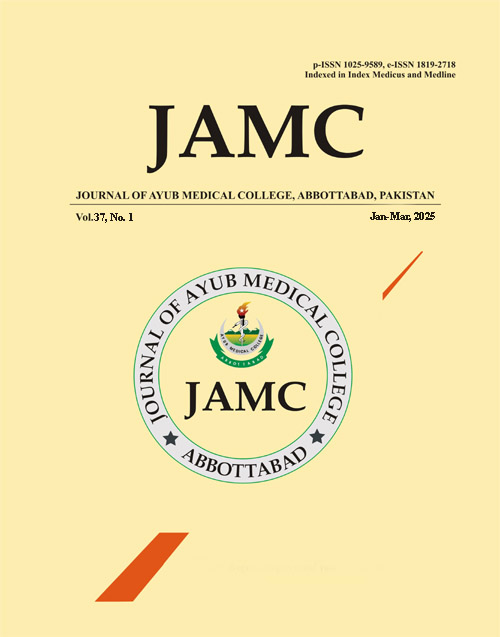CORRELATION OF GALL BLADDER WALL THICKNESS WITH SERUM PLATELETS COUNT AND HEMATOCRIT LEVELS IN DENGUE NSI POSITIVE PATIENTS
DOI:
https://doi.org/10.55519/JAMC-01-14273Abstract
Background: Dengue fever, a mosquito-borne viral infection holds pathophysiology in form of the alteration of hematological parameters, particularly platelet count and hematocrit levels, which are indicators of disease severity. Among the radiological workup, gallbladder wall thickening is a notable ultrasonographic finding in dengue patients. Objective was to determine the correlation of gall bladder wall thickness with serum platelets count and hematocrit in dengue NSI positive patients. Methods: A total of 250 enrolled patients underwent a clinical assessment that included measuring gallbladder wall thickness via ultrasonography by trained radiologists, determining serum platelet count using standard hematology analyzers, and assessing hematocrit levels with standard laboratory techniques. These measurements were taken at consistent intervals, such as on admission and on days 3 and 5. An abdominal ultrasound was conducted by a single physician using portable bedside equipment, and all other clinical and laboratory data were obtained from the patients' electronic records.
Results: The mean age of the patients was 49.52±8.50 years. Gallbladder wall thickness was less than 3 mm in 50.9%, between 4-6 mm in 46.4%, and 7 mm or more in 2.7%. A significant inverse correlation was found between gallbladder wall thickness and platelet count (ρ = -0.861, p = 0.000) and a strong positive correlation with hematocrit levels (ρ = 0.873, p = 0.000). Conclusion: The present study concluded that evaluation of gallbladder wall thickness is an important step when performed in conjugation with serum platelets count and hematocrit in dengue fever to predict the disease severity and thus aids in the management and improving the outcome in dengue prone areas.
References
1. Dehghani R, Kassiri H. A review on epidemiology of dengue viral infection as an emerging disease. Research Journal of Pharmacy and Technology. 2021;14(4):2296-301.
2. Halstead SB. Dengue hemorrhagic fever. CRC Handbook of Viral and Rickettsial Hemorrhagic Fevers: CRC Press; 2019. p. 85-94.
3. Abhijit N. Comparative Study of Ultrasonographic Findings with Clinico Lab Findings in Dengue Fever: Rajiv Gandhi University of Health Sciences (India); 2020.
4. Rai DA, Azad DS, Nautiyal DS, Acharya DS. Correlation between hematological and serological parameters in dengue patients-an analysis of 2022 cases. Trop J Pathol Microbiol. 2019;5(8):547-54.
5. Bhatt S, Gething PW, Brady OJ, Messina JP, Farlow AW, Moyes CL, et al. The global distribution and burden of dengue. Nature. 2013;496(7446):504-7.
6. Jayadas T, Kumanan T, Arasaratnam V, Gajapathy K, Surendran SN. The clinical profile, hematological parameters and liver transaminases of dengue NS1 Ag positive patients admitted to Jaffna Teaching Hospital, Sri Lanka. BMC research notes. 2019;12:1-5.
7. Balasubramanian S, Janakiraman L, Kumar SS, Muralinath S, Shivbalan S. A reappraisal of the criteria to diagnose plasma leakage in dengue hemorrhagic fever. Indian pediatrics. 2006;43(4):334.
8. Thomas SJ, Endy TP. Critical issues in dengue vaccine development. Current opinion in infectious diseases. 2011;24(5):442-50.
9. Muktar Y, Tamerat N, Shewafera A. Aedes aegypti as a Vector of Flavivirus. J Trop Dis. 2016;4(223):2.
10. Guzman A, Istúriz RE. Update on the global spread of dengue. International journal of antimicrobial agents. 2010;36:S40-S2.
11. Kabra S, Jain Y, Pandey R, Singhal T, Tripathi P, Broor S, et al. Dengue haemorrhagic fever in children in the 1996 Delhi epidemic. Transactions of the royal society of tropical medicine and Hygiene. 1999;93(3):294-8.
12. Setiawan MW, Samsi TK, Wulur H, Sugianto D, Pool TN. Epigastric pain and sonographic assessment of the pancreas in dengue hemorrhagic fever. Journal of clinical ultrasound. 1998;26(5):257-9.
13. Khanam M, Ferdoucy SA, Rahat F, Iman K, Hossain RMM, Chowdhury AM. Gallbladder Wall Thickening for Early Detection of Plasma Leakage Among Children with Dengue Fever Admitted in a Tertiary Care Hospital. Bangladesh Journal of Child Health. 2022;46(3):138-43.
14. Moras EC, Raj N, Achappa B, Holla R, Madi D, Mahalingam S. Hyperferritinemia and Gallbladder Wall Oedema as Early Markers of a Severe Dengue Infection in a Developing Nation. 2020.
15. Rasool FK, Rasool AK, Meraj L, Bashir F. Ultrasound As An Aid To Diagnosis In Dengue. Journal of Rawalpindi Medical College. 2023;27(1).
16. Singh S, Saxena G, Singh D, Gupta D, Shoaib M, Neelam. Association of gallbladder wall thickening and haematocrit values with severity in patients of dengue fever. 2022.
Downloads
Published
How to Cite
Issue
Section
License
Copyright (c) 2025 Saneela Mumtaz, Hooria Asif, Ayesha Nayab, Ayesha Qazi, Shahid Hussain

This work is licensed under a Creative Commons Attribution-NoDerivatives 4.0 International License.
Journal of Ayub Medical College, Abbottabad is an OPEN ACCESS JOURNAL which means that all content is FREELY available without charge to all users whether registered with the journal or not. The work published by J Ayub Med Coll Abbottabad is licensed and distributed under the creative commons License CC BY ND Attribution-NoDerivs. Material printed in this journal is OPEN to access, and are FREE for use in academic and research work with proper citation. J Ayub Med Coll Abbottabad accepts only original material for publication with the understanding that except for abstracts, no part of the data has been published or will be submitted for publication elsewhere before appearing in J Ayub Med Coll Abbottabad. The Editorial Board of J Ayub Med Coll Abbottabad makes every effort to ensure the accuracy and authenticity of material printed in J Ayub Med Coll Abbottabad. However, conclusions and statements expressed are views of the authors and do not reflect the opinion/policy of J Ayub Med Coll Abbottabad or the Editorial Board.
USERS are allowed to read, download, copy, distribute, print, search, or link to the full texts of the articles, or use them for any other lawful purpose, without asking prior permission from the publisher or the author. This is in accordance with the BOAI definition of open access.
AUTHORS retain the rights of free downloading/unlimited e-print of full text and sharing/disseminating the article without any restriction, by any means including twitter, scholarly collaboration networks such as ResearchGate, Academia.eu, and social media sites such as Twitter, LinkedIn, Google Scholar and any other professional or academic networking site.










